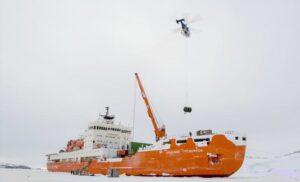 Station N (1) Bay of Isles
Station N (1) Bay of Isles
A small expedition consisting of W. N. Bonner and B. Stonehouse, funded by Falkland Islands Dependencies Government and administered by FIDS, did allocate letter ”N” to the station set at 54°03’South, 37°23’West, at Ample Bay, Bay of Isles, South Georgia . The initial though, even if that was later considered a private expedition, Station N (1) was set to study Biology and was occupied from 1953 through 1955.
The buildings consist in a main hut and small store hut. Main hut had burnt down by 1974. Debris were removed in the Antarctic season 2005/06.
(Thanks and credit: https://www.bas.ac.uk/wp-content/uploads/2015/03/British-Antarctic-Stations-Refuges-v6.2-2016.pdf )
Station N (“2”) Anvers Island (WAP GBR-28) & Old Palmer Station (WAP USA-33)
 On Anvers Island, the British Antarctic Survey built and operated a Station (Base N “2”) Anvers Island at Arthur Harbour, 64°46’ South, 64°05’ West, with purpose of survey and geology. (Pic aside show the Base as it was in 1955)
On Anvers Island, the British Antarctic Survey built and operated a Station (Base N “2”) Anvers Island at Arthur Harbour, 64°46’ South, 64°05’ West, with purpose of survey and geology. (Pic aside show the Base as it was in 1955)
It was occupied from 28 Feb. 1955 until 10 Jan. 1958. Closed in 1958 when local work completed. Pic aside show Base N, Anvers Island, 1955-56. (Photographer: Alexander Rennie; Archives ref: AD6/19/3/C/N1)
Thanks and credit to: https://www.bas.ac.uk/about/about-bas/history/british-research-stations-and-refuges/anvers-island-n/
 The Hut at Station (Base N “2”) was loaned to the U.S. Government on July 2, 1963, which converted it into a biological laboratory and added a new building (the red one on the pic aside) in January 1965 for use by American scientists at the nearby Palmer Station.
The Hut at Station (Base N “2”) was loaned to the U.S. Government on July 2, 1963, which converted it into a biological laboratory and added a new building (the red one on the pic aside) in January 1965 for use by American scientists at the nearby Palmer Station.
Palmer Station “Old” (WAP USA-33) and “New” (WAP USA-23)
 The actual facility (WAP USA-23) at 64°46’27” South, 64°03’10” West is practically the second Palmer Station and it’s located on Anvers Island (pic to the left).
The actual facility (WAP USA-23) at 64°46’27” South, 64°03’10” West is practically the second Palmer Station and it’s located on Anvers Island (pic to the left).
“Old Palmer” (WAP USA-33) built about 1965, was about half a mile to the northwest adjacent to the site of the British Antarctic Survey “Base N”, built in the mid-fifties. The site is on what is now known as Amsler Island. Rapid recession of the ice due to global warming revealed Amsler Island as a separate island in 2004.
Amsler Island was the original site of the United States Antarctic Program research base Palmer (Old Palmer, WAP USA-33) from 1965 until the current station approximately 0.8 km (0.5 mi) away was constructed in 1968.
 WAP USA-33, “Old Palmer” (Pic to the right) served as a base for those building “New Palmer”, which opened in 1968. Old Palmer was designated as an emergency refuge for the new station in case of disaster, though this perceived need disappeared over time. It was dismantled and removed from the Antarctic as part of the National Science Foundation’s environmental cleanup efforts in the early 1990s. According to Mehdi F5PFP, Old Palmer Station at Arthur Harbour was active on air by KC4AAC 1963 & KC4USP 1965 .
WAP USA-33, “Old Palmer” (Pic to the right) served as a base for those building “New Palmer”, which opened in 1968. Old Palmer was designated as an emergency refuge for the new station in case of disaster, though this perceived need disappeared over time. It was dismantled and removed from the Antarctic as part of the National Science Foundation’s environmental cleanup efforts in the early 1990s. According to Mehdi F5PFP, Old Palmer Station at Arthur Harbour was active on air by KC4AAC 1963 & KC4USP 1965 .
WAP did issue a separate reference to “Old Palmer Station” at Anvers Island/Amsler Island 11 years ago (2009) to recognize the two distinct evolution phases of the history of both Palmer Bases .
 Station N (2) was re-open by the British in support of air facility 1969-1971 (pic to the left).
Station N (2) was re-open by the British in support of air facility 1969-1971 (pic to the left).
On 28 Dec 1971 the station has been destroyed by fire while being renovated by BAS. Debris was removed by the members of the US Antarctic Program in 1990/91. Only concrete foundations remain.
The Skiway on Marr Ice Piedmont was used 1969-1973 and then intermittently until 15 Nov 1993, and once in Dec 1999.
Air operations have been transferred to Adelaide (Station T) WAP GBR-13 in 1973 when the skiway found deteriorated.
 Dear friends, followers and Antarctic chasers,
Dear friends, followers and Antarctic chasers,

 This marks the start of a month-long “Sea Trials Phase” and an important milestone for all involved in the icebreaker project across the Australian Antarctic Division, ship managers Serco and ship builders Damen.
This marks the start of a month-long “Sea Trials Phase” and an important milestone for all involved in the icebreaker project across the Australian Antarctic Division, ship managers Serco and ship builders Damen.

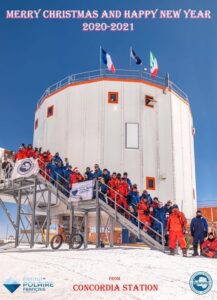
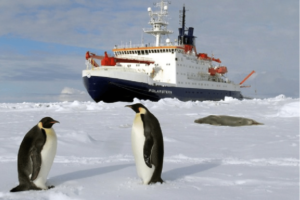 On Tuesday Dec. 22, the German Research Icebreaker Polarstern left the port of Bremerhaven. On board YL Theresa DC1TH and Felix DL5XL. They are now on the way direct down to Antarctica. DPØPOL/MM has already been reported QRV on 20 mts CW.
On Tuesday Dec. 22, the German Research Icebreaker Polarstern left the port of Bremerhaven. On board YL Theresa DC1TH and Felix DL5XL. They are now on the way direct down to Antarctica. DPØPOL/MM has already been reported QRV on 20 mts CW. 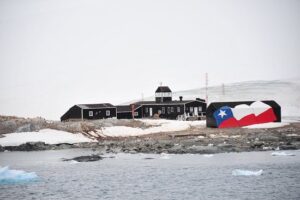 PCR swab tests given to Chilean researchers at the General Bernardo O’Higgins Riquelme (pic aside) came back positive.
PCR swab tests given to Chilean researchers at the General Bernardo O’Higgins Riquelme (pic aside) came back positive.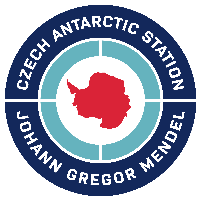 Despite the current situation, the Czech Antarctic Research Program will continue with field research. An eight-member team has departed from Prague on Wednesday, December 16th to Chile, where they will quarantine at a hotel, before heading on to
Despite the current situation, the Czech Antarctic Research Program will continue with field research. An eight-member team has departed from Prague on Wednesday, December 16th to Chile, where they will quarantine at a hotel, before heading on to  The expedition will be led by climatologist and polar explorer Kamil Láska from the Department of Geography, at Masaryk University’s Faculty of Science. The operation of the station will be overseen by technicians from Czechoslovak Ocean Shipping, František Vorel and Tomáš Spáčil.
The expedition will be led by climatologist and polar explorer Kamil Láska from the Department of Geography, at Masaryk University’s Faculty of Science. The operation of the station will be overseen by technicians from Czechoslovak Ocean Shipping, František Vorel and Tomáš Spáčil. The vessel, known as ‘Orange Roughy’, completed its last trip among the long list of its scientific expeditions for the Australian Antarctic Division on Dec 12.
The vessel, known as ‘Orange Roughy’, completed its last trip among the long list of its scientific expeditions for the Australian Antarctic Division on Dec 12.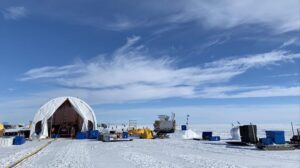 Located at 82°00’ South, 155° 00’ West, Siple Coast is the middle portion of the relatively ill-defined coast along the East side of the Ross Ice Shelf. Siple Coast is the grounding line of the West Antarctic Ice Sheet, where the ice meets the ocean and starts to float, becoming the Ross Ice Shelf. It is as far south as the ocean reaches anywhere in the world.
Located at 82°00’ South, 155° 00’ West, Siple Coast is the middle portion of the relatively ill-defined coast along the East side of the Ross Ice Shelf. Siple Coast is the grounding line of the West Antarctic Ice Sheet, where the ice meets the ocean and starts to float, becoming the Ross Ice Shelf. It is as far south as the ocean reaches anywhere in the world.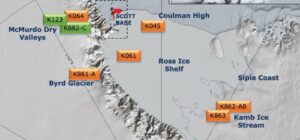 (See location 862AB on the map) This season’s main objective is to develop an understanding of the nature of the sea-floor sediments. Future retrieval of deep sediment cores will help inform multidisciplinary studies of the stability of the Ross Ice Shelf during past warm periods. Drill holes at the Siple Coat will also support the United States Icefin project. Icefin is an under-ice robot designed to explore ice-ocean environments here on Earth and ultimately on Jupiter’s icy moon named Europa.
(See location 862AB on the map) This season’s main objective is to develop an understanding of the nature of the sea-floor sediments. Future retrieval of deep sediment cores will help inform multidisciplinary studies of the stability of the Ross Ice Shelf during past warm periods. Drill holes at the Siple Coat will also support the United States Icefin project. Icefin is an under-ice robot designed to explore ice-ocean environments here on Earth and ultimately on Jupiter’s icy moon named Europa. Station N (1) Bay of Isles
Station N (1) Bay of Isles  On Anvers Island, the British Antarctic Survey built and operated a Station (Base N “2”) Anvers Island at Arthur Harbour, 64°46’ South, 64°05’ West, with purpose of survey and geology. (Pic aside show the Base as it was in 1955)
On Anvers Island, the British Antarctic Survey built and operated a Station (Base N “2”) Anvers Island at Arthur Harbour, 64°46’ South, 64°05’ West, with purpose of survey and geology. (Pic aside show the Base as it was in 1955) The Hut at Station (Base N “2”) was loaned to the U.S. Government on July 2, 1963, which converted it into a biological laboratory and added a new building (the red one on the pic aside) in January 1965 for use by American scientists at the nearby Palmer Station.
The Hut at Station (Base N “2”) was loaned to the U.S. Government on July 2, 1963, which converted it into a biological laboratory and added a new building (the red one on the pic aside) in January 1965 for use by American scientists at the nearby Palmer Station. The actual facility (WAP USA-23) at 64°46’27” South, 64°03’10” West is practically the second Palmer Station and it’s located on Anvers Island (pic to the left).
The actual facility (WAP USA-23) at 64°46’27” South, 64°03’10” West is practically the second Palmer Station and it’s located on Anvers Island (pic to the left). WAP USA-33, “Old Palmer” (Pic to the right) served as a base for those building “New Palmer”, which opened in 1968. Old Palmer was designated as an emergency refuge for the new station in case of disaster, though this perceived need disappeared over time. It was dismantled and removed from the Antarctic as part of the National Science Foundation’s environmental cleanup efforts in the early 1990s. According to Mehdi F5PFP, Old Palmer Station at Arthur Harbour was active on air by KC4AAC 1963 & KC4USP 1965 .
WAP USA-33, “Old Palmer” (Pic to the right) served as a base for those building “New Palmer”, which opened in 1968. Old Palmer was designated as an emergency refuge for the new station in case of disaster, though this perceived need disappeared over time. It was dismantled and removed from the Antarctic as part of the National Science Foundation’s environmental cleanup efforts in the early 1990s. According to Mehdi F5PFP, Old Palmer Station at Arthur Harbour was active on air by KC4AAC 1963 & KC4USP 1965 . Station N (2) was re-open by the British in support of air facility 1969-1971 (pic to the left).
Station N (2) was re-open by the British in support of air facility 1969-1971 (pic to the left).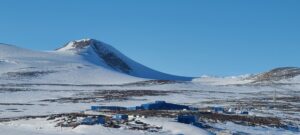 WAP
WAP Lee sent us some pics which we are happy to share with the readers. After stopping by at Jangbogo Station (WAP KOR-Ø2) Lee is expect to reach King Sejong Base (WAP KOR-Ø1)at beginning of January for a long stay.
Lee sent us some pics which we are happy to share with the readers. After stopping by at Jangbogo Station (WAP KOR-Ø2) Lee is expect to reach King Sejong Base (WAP KOR-Ø1)at beginning of January for a long stay.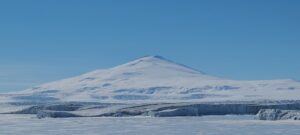
 The ice-breaking research vessel Araon was built in 2009 and is sailing under the flag of Korea. She did explore the South and North Pole regions on several missions since 2009 as part of global efforts to examine the cause of global warming and study the Arctic & Antarctic ecosystem.
The ice-breaking research vessel Araon was built in 2009 and is sailing under the flag of Korea. She did explore the South and North Pole regions on several missions since 2009 as part of global efforts to examine the cause of global warming and study the Arctic & Antarctic ecosystem.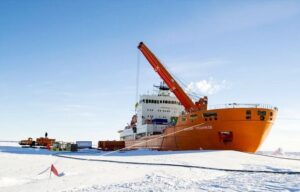 Icebreaker AKADEMIK TRYOSHNIKOV (IMO 9548536, MMSI 273359440, Callsign UBXH3) was reported two days ago by MarinecTraffic Terrestrial Automatic Identification System as sailing in the Atlantic Ocean.
Icebreaker AKADEMIK TRYOSHNIKOV (IMO 9548536, MMSI 273359440, Callsign UBXH3) was reported two days ago by MarinecTraffic Terrestrial Automatic Identification System as sailing in the Atlantic Ocean.